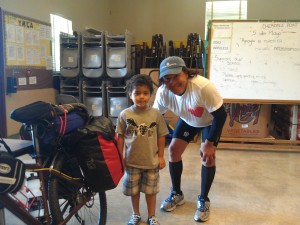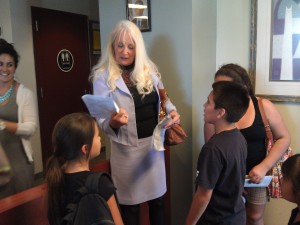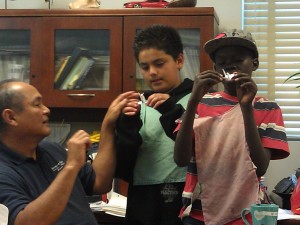 “Rider for Change” James Encinas arrived by mountain bike at San Diego’s Cherokee Point Elementary May 2 to the delight of some hundred students, and visitors from around southern California. James, a career LA school teacher, is riding 3,000 miles from Sacramento to Philadelphia. He’ll take the southern route through Texas and Louisiana, then follow the Underground Railway by which African Americans escaping slavery crossed north to freedom.
“Rider for Change” James Encinas arrived by mountain bike at San Diego’s Cherokee Point Elementary May 2 to the delight of some hundred students, and visitors from around southern California. James, a career LA school teacher, is riding 3,000 miles from Sacramento to Philadelphia. He’ll take the southern route through Texas and Louisiana, then follow the Underground Railway by which African Americans escaping slavery crossed north to freedom.
James is riding to draw national attention to the need for “trauma-informed schools,” key to the movement for “Trauma-Informed Care (TIC)” in education, health, and all public systems. But what is Trauma-Informed Care, and what’s a trauma-informed school ? (Hint: all the pix in this blog are from Cherokee Point).
“In medicine, a patient is sent to hospice when all medical procedures have failed, and they’re going to die. That says: we give care and comfort only when nothing else works,”notes Dr. Christopher Germer, psychology prof at Harvard Medical School and co-editor of Mindfulness and Psychotherapy. Pretty crazy right there, if you consider. Been in a hospital lately? Often you’re a widget; they take your clothes away, don’t tell you what’s happening, and so on. [FN1]
 But when treating the real human being, “Care Equals Cure,” says Dr. Germer. If a therapist doesn’t care, he’s not going to cure his client. But it’s also true in any dealings with humans. “Care IS the practice of non-resistance to suffering which dismantles emotional suffering,” says Germer. “It means opening to emotional pain more fully, instead of trying to bypass it. Compassion opens the heart, reveals inner suffering, and makes the suffering available for transformation.” (Above: James and activists carry food donated for kids.)
But when treating the real human being, “Care Equals Cure,” says Dr. Germer. If a therapist doesn’t care, he’s not going to cure his client. But it’s also true in any dealings with humans. “Care IS the practice of non-resistance to suffering which dismantles emotional suffering,” says Germer. “It means opening to emotional pain more fully, instead of trying to bypass it. Compassion opens the heart, reveals inner suffering, and makes the suffering available for transformation.” (Above: James and activists carry food donated for kids.)
“So the message is: Stop fixing,and start caring,” Dr. Germer concludes. In fact, it’s brain science. Comfort, care, compassion reduce so much of a human’s fight-flight reflex, even in major medical pain, that this has been shown to heal surgeries faster. Pain and bodily trauma create enough fight-flight that the brain stem often shuts down the immune system, for one. Compassion helps it come back online. “Let a wounded soldier talk to his mom and he’ll require 50% less pain meds,” says Dr. Bruce Perry, MD.
But could it be necessary or work well in schools?
History of Trauma-Informed Care (TIC)
 TIC goes back to 1994 when the federal Substance Abuse and Mental Health Services Administration (SAMHSA) began to study the remarkably high rate of women in the mental health system with histories of physical and sexual abuse trauma. It became clear that, since such clients came in already pre-traumatized, providers should be mindful lest their own practices and policies put the women in danger, physically or emotionally, or lead to re-traumatization. (Activist Dana Brown with youth leaders.)
TIC goes back to 1994 when the federal Substance Abuse and Mental Health Services Administration (SAMHSA) began to study the remarkably high rate of women in the mental health system with histories of physical and sexual abuse trauma. It became clear that, since such clients came in already pre-traumatized, providers should be mindful lest their own practices and policies put the women in danger, physically or emotionally, or lead to re-traumatization. (Activist Dana Brown with youth leaders.)
These and related studies next showed high rates of earlier life trauma in clients seeking services for substance abuse, domestic violence, child welfare and many other areas. In 2005 SAMSHA created the National Center for Trauma-Informed Care (NCTIC) to assist all public programs to implement Trauma-Informed Care, not only in mental health, but in all services including criminal justice and the education system. [FN 2]
“NCTIC seeks to change the paradigm from one that asks, “What’s wrong with you?” to one that asks, “What has happened to you?” says SAMHSA. “Trauma includes physical, sexual and institutional abuse, neglect, inter-generational trauma, and disasters that induce powerlessness, fear, hopelessness, and a constant state of alert…often resulting in recurring feelings of shame, guilt, rage, isolation, and disconnection.”
It’s impossible to successfully treat human beings in that condition without recognizing this and at least following the principle of “Do No Harm.” “When a program becomes trauma-informed, every part of its organization and service delivery system is assessed… to include a basic understanding of how trauma affects the life of an individual,” SAMHSA notes.
 Schools are key, since all Americans are supposed to spend 13 years there. “If fixing school discipline were a political campaign, the slogan would be ‘It’s the Adults, Stupid!’,” says Jane Stevens, founder of ACEsConnection; “More than three million kids are suspended or expelled each year” in the U.S., 3.4 million in 2006 according to the National Center for Education. “But punishment doesn’t change behavior; it just drops hundreds of thousands of kids into a school to prison pipeline.” (Above: Kids ask James questions.)
Schools are key, since all Americans are supposed to spend 13 years there. “If fixing school discipline were a political campaign, the slogan would be ‘It’s the Adults, Stupid!’,” says Jane Stevens, founder of ACEsConnection; “More than three million kids are suspended or expelled each year” in the U.S., 3.4 million in 2006 according to the National Center for Education. “But punishment doesn’t change behavior; it just drops hundreds of thousands of kids into a school to prison pipeline.” (Above: Kids ask James questions.)
“Instead of waiting for kids to behave badly then punishing them, trauma-informed schools are creating environments in which kids can succeed,” she says. It’s about re-training the adults to drop their fears and assume that kids are basically good, but something traumatized them, so they act out. Bad behavior isn’t accepted and it is corrected – by a dialog with kids to hear what’s hurting inside, and show them how to address it. “Focus on altering behavior of teachers and administrators, and kids stop fighting and acting out in class. They’re more interested in school, they’re happier and feel safer,” Stevens says. [FN3]
See the Grade or see the Person?
As SAMHSA began trauma studies in 1994, the Adverse Childhood Experiences (ACE) Study (1994-98) documented a shocker: about 50% of Americans have significant child trauma. The 17,421 HMO clients studied were privileged to be mostly college-educated, have jobs and good health care. Yet more than half had two of ten types of childhood trauma: physical abuse; sexual abuse; alcoholic or drug addict parent; family member in jail; battered mother; parent with mental illness; loss of a parent; physical neglect, emotional neglect; or verbal/emotional abuse.
The ACE Study compared their childhoods, to whether they later developed life-threatening physical conditions and/or addictions. “It found that those 10 types of severe and chronic childhood traumas up the risk of adult onset of major diseases. But it also increases the chances of being violent, a victim of violence and becoming chronically depressed,” Stevens reports in a terrific post on Cherokee Point El. “Brain research revealed one reason: the toxic stress of trauma damages the structure and function of a child’s brain. Kids get anxious and can’t sit still; get depressed and withdraw; get angry and fight; can’t focus and stop learning. They cope with anxiety, depression, anger by drinking, smoking, drugs, fighting, stealing, overeating, and/or becoming overachievers on their way to being workaholics.”
What about not-so-privileged kids? Child trauma and its mortal results must affect a far higher percentage of kids in low-income areas with less access to nutrition, health care, and on and on. A huge percentage of American children suffer trauma, bigger than 50% if we knew the real national average.
 Meanwhile many of us privileged middle class kids grow up to be teachers, administrators, and so on. If we’re traumatized ourselves, we can’t feel our feelings– so we believe that considering “feelings” is idiotic. Instead, we set up schools as a place to tell kids things. Because adults talked at us, we think it’s adult to talk at kids. We tell kids they are there to listen to information and repeat it back as we want it, ie. “get the grade,” or face trouble. Enough to put anyone into fight-flight. (James Encinas, left, with students, Principal Godwin Higa, activists.)
Meanwhile many of us privileged middle class kids grow up to be teachers, administrators, and so on. If we’re traumatized ourselves, we can’t feel our feelings– so we believe that considering “feelings” is idiotic. Instead, we set up schools as a place to tell kids things. Because adults talked at us, we think it’s adult to talk at kids. We tell kids they are there to listen to information and repeat it back as we want it, ie. “get the grade,” or face trouble. Enough to put anyone into fight-flight. (James Encinas, left, with students, Principal Godwin Higa, activists.)
I’m from that privileged middle class. I often say, “Nobody beat me or raped me; what’s wrong with me?”
 On Feb. 25 this year, I heard Ruth Beaglehole, founder of Echo Parenting and Education, address Echo’s annual Los Angeles meeting. Urging the 150 professionals present to get passionate about raising awareness of child trauma, she said, “Kids have to live in the real world? Make the real world non-violent and trauma-sensitive! What about creating places where children can seek safety, where children can come home to people who open their arms, attune to them, and say ‘Tell me what happened today’. ” (Above: Principal Higa helps Cherokee students make origami cranes for charity.)
On Feb. 25 this year, I heard Ruth Beaglehole, founder of Echo Parenting and Education, address Echo’s annual Los Angeles meeting. Urging the 150 professionals present to get passionate about raising awareness of child trauma, she said, “Kids have to live in the real world? Make the real world non-violent and trauma-sensitive! What about creating places where children can seek safety, where children can come home to people who open their arms, attune to them, and say ‘Tell me what happened today’. ” (Above: Principal Higa helps Cherokee students make origami cranes for charity.)
“Some people define that as a report card and demand, ‘I want to see your grades.’ Enough of these bloody grades!” Ruth said, to audience laughter, including mine. “Why do we accept this? Why do we accept that that’s the definition of a person — their grades?”
Suddenly out of nowhere I began violently sobbing at my table full of therapists, about 20 feet from the podium. “I see you,” Ruth said, looking straight at me. “You don’t have to hold it back.” She saw the real person I am, she didn’t need me to fake anything. She was willing to simply be with me in the pain, as Chris Germer said: “Stop fixing, start caring.” Boy did that feel good. [FN4]
I knew I always hated having to go out and get that grade, and it better be above 90 “or else.” So I did it, but I lived in fear. They didn’t see me. I was a widget who had to produce results or there’d be trouble.
Back story? On Feb. 8, 2011, I’d just heard I might have a thing called “attachment disorder.” Late one night I dragged myself to the sink to wash, listening to a CD by Dr. Henry Cloud. He joked about a lady who didn’t like her husband to go bowling: “She’s not old enough to be dropped off at school.” But it wasn’t funny. [FN5]
“That’s it: I wasn’t old enough to be dropped off at school,” I journaled, “I was just dumped off.” Terrified, I slumped in a heap sobbing, clutching a stuffed dog and a soggy toothbrush. Rising an hour later, I couldn’t even brush my teeth without holding the dog. “I’m really frightened because I don’t know if this hole under my feet ever ends,” I muttered into my pocket recorder.
I didn’t know last February but read later that Ruth was born in New Zealand to prestigious academic parents who didn’t see Ruth, either. “I baby-sat since age 12, trying to give to vulnerable children what I didn’t get,” she says. So she took a BA in early childhood ed, moved to LA, got a Masters in family therapy, and grew Echo Parenting into an agency of 23 staff that trains 100 professionals a year in service.
 What if Ruth’s right? What if a school’s whole mission were to look at each child and say “I see you”? “I see you as a human being, I care how you’re feeling today, and I care what feelings and fears you’re bringing in the door. I care if you feel threatened even before you walk in the door. I want to get to know you, the real you who is. That way we can make you feel safe to be here in school. And then, you’ll really want to learn!” (One of many posters students did for James Encinas.)
What if Ruth’s right? What if a school’s whole mission were to look at each child and say “I see you”? “I see you as a human being, I care how you’re feeling today, and I care what feelings and fears you’re bringing in the door. I care if you feel threatened even before you walk in the door. I want to get to know you, the real you who is. That way we can make you feel safe to be here in school. And then, you’ll really want to learn!” (One of many posters students did for James Encinas.)
———————————
Kathy’s news blogs expand on her book “DON’T TRY THIS AT HOME: The Silent Epidemic of Attachment Disorder—How I accidentally regressed myself back to infancy and healed it all.” Watch for the continuing series each Friday, as she explores her journey of recovery by learning the hard way about Attachment Disorder in adults, adult Attachment Theory, and the Adult Attachment Interview.
Footnotes
FN1 Christopher Germer, PhD, “Open Heart, Open Eyes: Self-Compassion,” speech to 20th Annual Conference on Psychology of Health, Immunity and Disease, National Institute for the Clinical Application of Behavioral Medicine (NICABM), Hilton Head SC, Dec.2008
Dr. Germer [http://www.mindfulselfcompassion.org/ and http://www.centerformsc.org/ ] is a founding member of the Institute for Meditation and Psychotherapy, a clinical instructor in psychology at Harvard Medical School, author of The Mindful Path to Self-Compassion, and co-editor of Mindfulness and Psychotherapy. His meditation MP3 are here: http://www.mindfulselfcompassion.org/meditations_downloads.php “Why Self-Compassion is Becoming a Psychotherapist’s Best Between-Sessions Tool,” Dr. Chris Germer interview by Dr. Ruth Buczynski, Sept 13, 2009 is at http://www.nicabm.com/nicabmblog/can-self-compassion-become-a-portable-between-session-tool/
FN2 The Substance Abuse and Mental Health Services Administration (SAMHSA) is the agency within the U.S. Department of Health and Human Services that leads public health efforts to advance the behavioral health of the nation. Websites on TIC: http://www.samhsa.gov/nctic/ ; http://www.samhsa.gov/nctic/trauma.asp
FN3 Jane Stevens, ACEsConnection.com and ACEsTooHigh.com: http://blogs.psychcentral.com/organizations/2014/04/5-reasons-we-struggle-to-be-trauma-responsive-and-why-the-struggle-should-continue/
Massachusetts, Washington State lead U.S. trauma-sensitive school movement
The secret to fixing school discipline problems? Change the behavior of adults
FN4 Ruth Beaglehole, founder of Echo Parenting and Education, address to Echo’s annual Los Angeles meeting “Developmental Trauma: Changing the Paradigm,” Feb. 25, 2014
FN5 Dr. Henry Cloud, PhD, “Character Discernment for Dummies, Part 2,” CD, Dec. 6, 2010, www.CloudTownsendResources.com
![]()



Thank you Shelley! I’m sure no expert on TIC; in fact I knew so little that when I realized TIC had such a long history back to 2004, that’s why I decided to write this summary history – to try to make it clear to people who don’t know about it, starting with me!
But yes, I’ve read all about Jim Sporleder in the April 2012 piece Jane Stevens wrote on ACEsTooHigh.com; his work seems to be the national model for schools. Here’s the link: http://acestoohigh.com/2012/04/23/lincoln-high-school-in-walla-walla-wa-tries-new-approach-to-school-discipline-expulsions-drop-85/
Kathy, wonderful article! Are you familiar with the work of Dr. Christopher Blodgett at Washington State University? He and his team are ALL about this! They trained Jim Sporleder in Walla Walla in school trauma-informed-care and then the alternative high school he was principal of had its suspension rate drop by 85%! A very in-depth documentary has now been filmed of Jim’s high school and I can’t wait for it to be released to the public! Great stuff! 😀 ~ Shelley